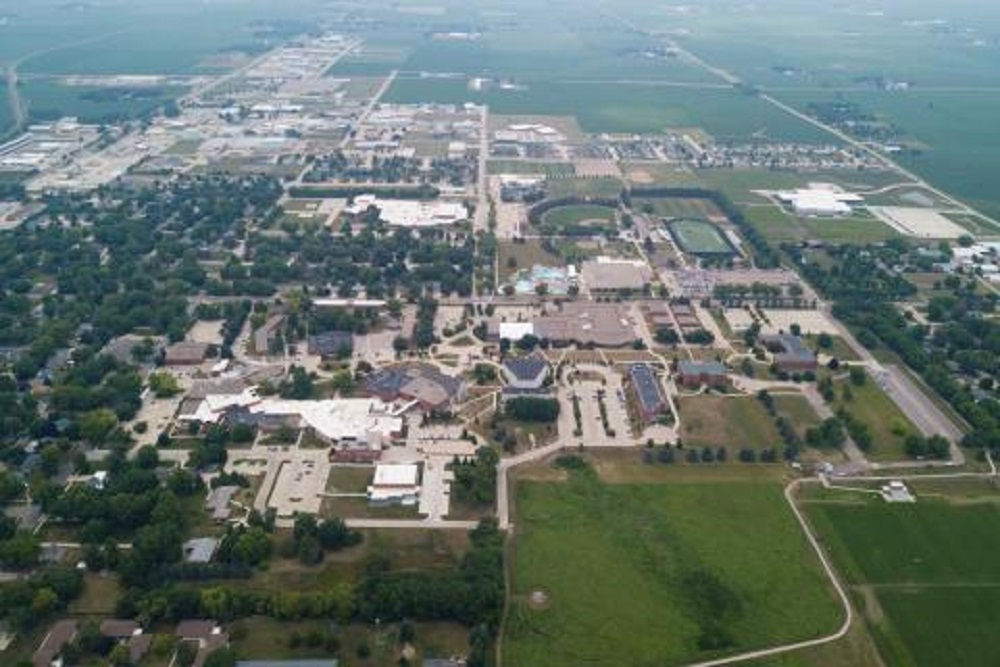How much economic value does Dordt University bring to Sioux County? A recent study conducted by Emsi Burning Glass shows that, in short, Dordt creates “a positive net impact on the county economy and generates significant return on investment for students and society and benefits for taxpayers.”
The study, which was based on the 2019-20 fiscal year, examines the impact that Dordt alumni, student spending, visitor spending, volunteerism, and operations spending has on the Sioux County economy—and it unearths some fascinating facts.
“One out of every 40 jobs in Sioux County exists simply because of and in support of Dordt University,” says Eric Tudor, director of emerging markets. “These are restaurants, hotels, recreation opportunities, and retail spaces that exist purely because of our students and visitors.” The study shows that Dordt creates $43.4 million in income to Sioux County, which is equal to approximately 1.6 percent of the total gross regional product of the county. The volunteerism of Dordt students alone supports seven jobs.
Tudor says that Emsi Burning Glass was “blown away” by Dordt’s visitor data. Dordt attracts approximately 100,000 visitors annually—an impact similar to hosting the World Series two times a year. The company says it usually sees visitor numbers like this for universities 10 times the size of Dordt.
“When you think of vacation hot spots, you might think of ski towns or lakeside communities,” says Tudor. “Emsi Burning Glass pointed out that, in many ways, Dordt University is the lake or mountain for Sioux County. People visit campus to attend our events, and they spend extra days in our community. People aspire to live near campus for the amenities our university offers. Dordt doesn’t look like a mountain or a lake, but in many ways, we act like one for our community.”
Throughout the year, visitors travel to Sioux County to watch Dordt’s athletic games, arts productions, and other events; while they are visiting Dordt, these individuals spend money at hotels, restaurants, gas stations, and more. According to the study, “the spending from these visitors added approximately $1.5 million in income or $8.8 million in sales for the Sioux County economy, which is equivalent to supporting 47 jobs.”
Student spending is another factor they considered. The study indicates that “student spending added approximately $2.9 million in income or $14.7 million in sales for Sioux County, which is equivalent to supporting 72 jobs.” Or, put another way, it’s enough to buy 236 families a year’s worth of groceries.
The economic impact study also looks at the return on investment of a Dordt education and the benefits that taxpayers receive from Dordt. Students pay tuition, purchase books and supplies, and spend their time on an education. Collectively, Dordt students forewent $31.4 million in wages to study at Dordt in 2020.
“In return for their investment, students will receive a cumulative present value of $103.3 million in increased earnings over their working lives, which translates to a return of $3.30 in higher future earnings for every dollar students invest in their Dordt education,” explains Tudor. “Said another way, the annual rate of return on an investment (ROI) in a Dordt education is 13 percent – well above that of a 30-year ROI in the stock market. If you’re choosing between putting $100,000 into the market at age 18 or going to Dordt, you’re better off here.”
And Dordt provides more than financial value; students grow spiritually and relationally during their time at Dordt.
“Our students make great friends and sometimes meet their spouses here. And, once they graduate, they aren’t going out and buying Lamborghinis with their first paycheck,” jokes Tudor.
The study shows that society gains $2.50 in added income and social savings through a Dordt graduate.
“Dordt graduates invest their money wisely. They make responsible decisions. They, in many cases, get married and raise families. They pay off their loans and live humbly—some might say counter-culturally—during their 20s, and they invest long-term. All of these factors have a very direct impact and influence on an economic region.”
One of the aspects of the study that Tudor finds most fascinating is the number of students who stay in the Sioux County area after graduation.
“Only about one in eight of our incoming students is from Sioux County; however, one in four choose to stay in Sioux County upon graduation. So, Dordt is a huge net importer of talent to the area,” he says. “A Dordt education attracts and retains people that every community in America is desperately searching for. And as a society, we’re in a time of disruption where people can work from home and move anywhere. Sioux County is a big winner—a place where people want to live—right now, and that’s atypical for an independent rural community in the Heartland.”
For years, President Erik Hoekstra has told Iowa’s governor and other government officials that Dordt is a net importer of people to Iowa and to Sioux County.
“With the economic impact study, we can quantify how the process of our graduates continuing to invest themselves in our state and region has a positive economic return,” he says. “We can see that our region is boosted economically by the presence, health, and dynamism of Dordt. We can confirm that we are responsible not only for the jobs created on campus, but that as our students, faculty, and staff circulate in the community we support so many other jobs. That’s truly energizing, and it’s stunning to realize how God has blessed Dordt over the more than 65 years of our existence.”
The report, which includes 97 pages of detailed information about the economic value of Dordt University, looks at a variety of sources, including internal and external data from the federal government. Every department on Dordt’s campus contributed data to the study. Tudor says that the report helps Dordt to gain a better understanding of what the institution brings to Sioux County and the city of Sioux Center.
“This report allows us to consider how we drive the local economy,” Tudor says. “It can also help us to consider how we as an institution align what we do in the classroom with what the local economy needs.” More than that, Tudor says, it gives Dordt a better understanding of the skill sets—including spiritual, social, and economic—students need to be great employees, parents, friends, and more in the communities where they live, whether that’s in Sioux County or elsewhere.
Original source can be found here.





 Alerts Sign-up
Alerts Sign-up